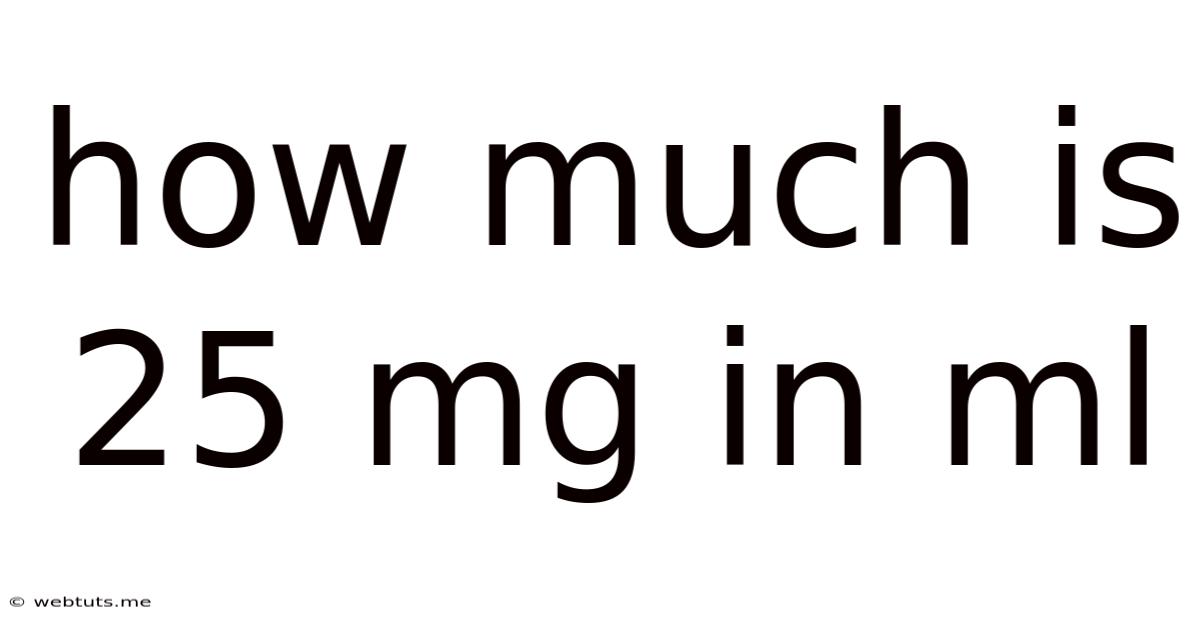How Much Is 25 Mg In Ml
Webtuts
May 13, 2025 · 4 min read

Table of Contents
How Much is 25 mg in ml? Understanding Concentration and Conversions
The question "How much is 25 mg in ml?" doesn't have a single answer. It's a common query, but understanding why requires grasping the concepts of concentration, density, and solubility. Simply put, milligrams (mg) measure mass while milliliters (ml) measure volume. You can't directly convert one to the other without knowing the substance's density or concentration.
Understanding the Key Concepts
Before diving into calculations, let's clarify the fundamental terms:
1. Mass (mg):
Mass refers to the amount of matter in a substance. Milligrams (mg) are a unit of mass. Think of it as how "heavy" something is.
2. Volume (ml):
Volume refers to the amount of space a substance occupies. Milliliters (ml) are a unit of volume. Think of it as how much space something takes up.
3. Density:
Density is the mass of a substance per unit volume. It's usually expressed as grams per milliliter (g/ml) or kilograms per liter (kg/L). A denser substance has more mass packed into the same volume. For example, lead is much denser than water; the same volume of lead weighs significantly more.
4. Concentration:
Concentration refers to the amount of a solute (the substance being dissolved) dissolved in a solvent (the substance doing the dissolving) to form a solution. It's often expressed as milligrams per milliliter (mg/ml), grams per liter (g/L), or as a percentage. A higher concentration means more solute is dissolved in the same volume of solvent.
Why You Need More Information
To convert 25 mg to ml, you need to know either the density of the substance or its concentration in a solution. Let's explore both scenarios:
Scenario 1: Knowing the Density
If you know the density of a substance, you can calculate its volume given its mass. The formula is:
Volume (ml) = Mass (mg) / Density (mg/ml)
Remember to ensure consistent units. If your density is given in g/ml, you need to convert your mass to grams (1 g = 1000 mg).
Example:
Let's say you have 25 mg of pure ethanol. The density of ethanol is approximately 0.789 g/ml. First, convert the mass to grams: 25 mg = 0.025 g.
Then, apply the formula:
Volume (ml) = 0.025 g / 0.789 g/ml ≈ 0.0317 ml
Therefore, 25 mg of ethanol would occupy approximately 0.0317 ml of volume.
Scenario 2: Knowing the Concentration
If you have a solution with a known concentration, you can calculate the volume containing 25 mg of the solute. The formula is:
Volume (ml) = Mass (mg) / Concentration (mg/ml)
Example:
You have a solution of ibuprofen with a concentration of 100 mg/ml. You want to know the volume containing 25 mg of ibuprofen.
Volume (ml) = 25 mg / 100 mg/ml = 0.25 ml
Therefore, 0.25 ml of this ibuprofen solution contains 25 mg of ibuprofen.
Common Substances and Their Densities (Approximate Values)
Keep in mind that these are approximate values and can vary based on temperature and other factors.
- Water: 1 g/ml (or 1000 mg/ml)
- Ethanol: 0.789 g/ml
- Mercury: 13.5 g/ml
- Gold: 19.3 g/ml
Practical Applications and Considerations
The conversion between mg and ml is crucial in various fields:
- Pharmacy: Calculating medication dosages. Pharmaceutical preparations often specify concentrations in mg/ml to ensure accurate dosing.
- Chemistry: Preparing solutions with specific concentrations for experiments.
- Food Science: Determining the amount of ingredients in recipes or food products.
- Environmental Science: Measuring pollutant concentrations in water or soil samples.
Important Note: When dealing with solutions, always ensure you are considering the concentration of the solute, not the overall density of the solution. The density of a solution will be different from the density of the pure solute.
Advanced Considerations: Solubility and Saturation
Another crucial factor is solubility. Not all substances dissolve completely in a given solvent. If you try to dissolve 25 mg of a substance with low solubility in 1 ml of a solvent, you might not achieve a homogeneous solution; some of the solute may remain undissolved. The concept of saturation is relevant here—a saturated solution holds the maximum amount of solute that can dissolve at a given temperature.
Conclusion
The conversion from mg to ml is not a straightforward calculation. It fundamentally depends on knowing either the density of a pure substance or the concentration of a solute in a solution. Understanding the concepts of mass, volume, density, concentration, solubility, and saturation is critical for accurate conversions and applications in various scientific and practical contexts. Always ensure consistent units and pay close attention to the context of the problem to avoid errors. Remember to consult reliable resources and reference materials for specific densities and concentrations of substances.
Latest Posts
Latest Posts
-
What Is 110 Kilometers In Miles Per Hour
May 13, 2025
-
How Many Meters Are In 3 Kilometers
May 13, 2025
-
How Much Is 1 4 Teaspoon Of Salt
May 13, 2025
-
How Many Hours In Five Days
May 13, 2025
-
400 Mg Potassium Chloride To Tsp
May 13, 2025
Related Post
Thank you for visiting our website which covers about How Much Is 25 Mg In Ml . We hope the information provided has been useful to you. Feel free to contact us if you have any questions or need further assistance. See you next time and don't miss to bookmark.